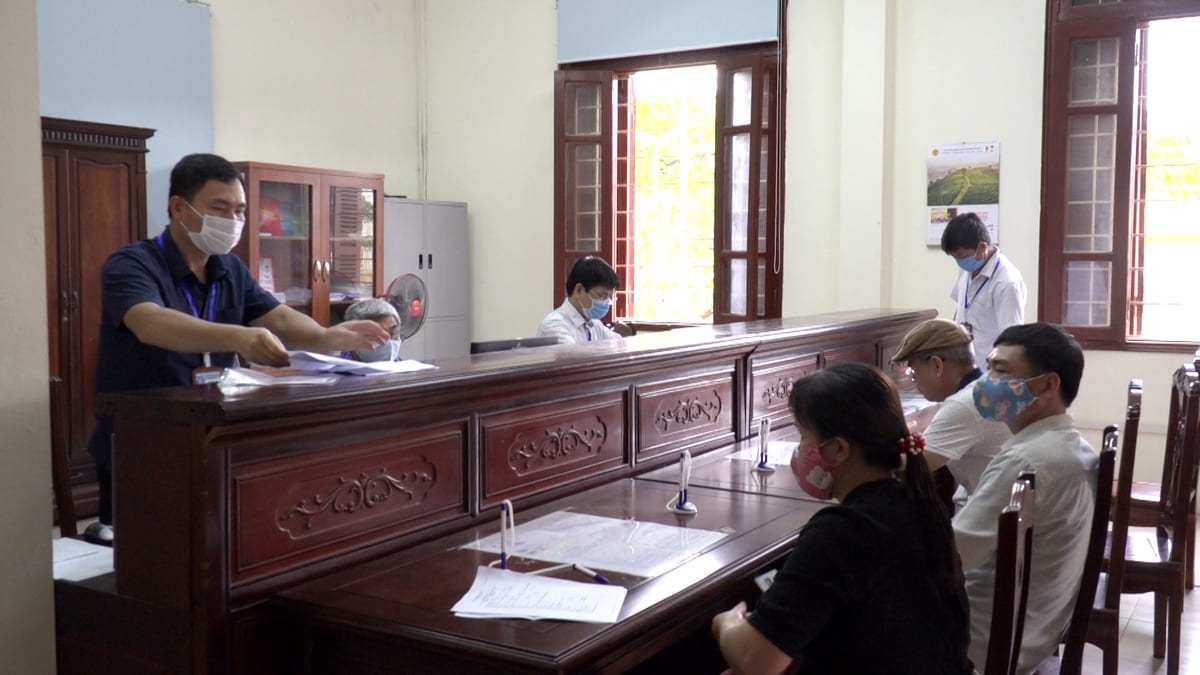
(HBO) – Robust achievements in tax collection were recorded in Lac Son and Yen Thuy districts of Hoa Binh province thanks to the sound direction of the provincial Taxation Department and the districts’ Party Committees and administrations, as well as smooth coordination between competent authorities.
.jpg) The taxation bureau in Lac
Son-Yen Thuy region receives and handles tax procedures for individuals and organisations
in a timely manner.
The taxation bureau in Lac
Son-Yen Thuy region receives and handles tax procedures for individuals and organisations
in a timely manner.
As of December 31, 2020, the taxation bureau collected nearly 173.5 billion VND
(7.57 million USD) in tax revenue, accounting for 81.8 percent of the National
Assembly’s estimate, 63.2 percent of the districts’ People’s Councils, and
189.5 percent of the figure recorded in the same time in 2019.
It completed five out of 11 criteria set by the National Assembly, including
granting right for mineral exploitation, non-agricultural land use tax, and
taxes on fees and charges. Meanwhile, the bureau failed to complete the
criteria of land use tax collection.
According to head of the bureau Tran Duc Tai, in a bid to complete the
entrusted missions, the bureau has taken measures to collect tax revenue in a
timely and effective fashion, and rectify working attitude of its staff.
Together with cutting unnecessary
administrative procedures, the bureau reported its challenges to the provincial
Taxation Department and the two districts’ Party Committees and People’s
Committees so that they could direct competent agencies to join hands with the
bureau to remove bottlenecks in state budget collection.
In the past year, the bureau paid due attention to improving the communication
work and support, making it easier for taxpayers have thorough understanding of
the current taxation policies.
Along with raising public awareness of the practical benefits of the online tax
registration and one-door mechanism for administrative procedures, it
maintained an event called "The week to listen to taxpayers” to settle tax
procedures in a timely manner and in accordance with regulations.
Right from the outset of the year, a wide range of measures were carried out to
improve quality of tax accounting and tax declaration. It also worked to
instruct newly-established firms use e-tax declaration and payment. To date,
all of the local firms have registered to make tax payment online.
Meanwhile, tax debt management work was carried out strictly and in accordance
with current regulations, helping the locality to collect over 5.5 billion VND
in tax arrears.
Additionally, through the emulation and commendation work, the bureau promoted
solidarity among its staff and encouraged tax officers to make efforts to
complete their entrusted missions./.
According to data from the Hoa Binh Provincial Party Committee, the industrial production index for the first six months of 2025 is estimated to have increased by 20% compared to the same period last year. This marks the highest year-on-year growth rate for this period since 2020.
In the first six months of 2025, Hoa Binh province’s export turnover was estimated at 1.145 billion USD, marking an 18.11% increase compared to the same period in 2024. Import turnover was estimated at $ 804 million, a 17.15% increase, which helped the province maintain a positive trade balance.
The lives of the ethnic minority farmers in Tan Lac district have gradually improved thanks to the new directions in agricultural production. This is a testament to the collective strength fostered through the professional associations and groups implemented by various levels of the district’s Farmers’ Union.
With the motto the "product quality comes first,” after nearly one year of establishment and operation, Muong village’s Clean Food Agricultural and Commercial Cooperative, located in Cau Hamlet, Hung Son Commune (Kim Boi district), has launched reputable, high-quality agricultural products to the market that are well-received by consumers. The products such as Muong village’s pork sausage, salt-cured chicken, and salt-cured pork hocks have gradually carved out a place in the market and they are on the path to obtaining the OCOP certification.
In the past, the phrase "bumper harvest, rock-bottom prices" was a familiar refrain for Vietnamese farmers engaged in fragmented, small-scale agriculture. But today, a new spirit is emerging across rural areas of Hoa Binh province - one of collaboration, organisation, and collective economic models that provide a stable foundation for production.
Maintaining growing area codes and packing facility codes in accordance with regulations is a mandatory requirement for agricultural products to be eligible for export. Recently, the Department of Agriculture and Environment of Hoa Binh province has intensified technical supervision of designated farming areas and packing facilities to safeguard the "green passport" that enables its products to access international markets.



.jpg) The taxation bureau in Lac
Son-Yen Thuy region receives and handles tax procedures for individuals and organisations
in a timely manner.
The taxation bureau in Lac
Son-Yen Thuy region receives and handles tax procedures for individuals and organisations
in a timely manner.